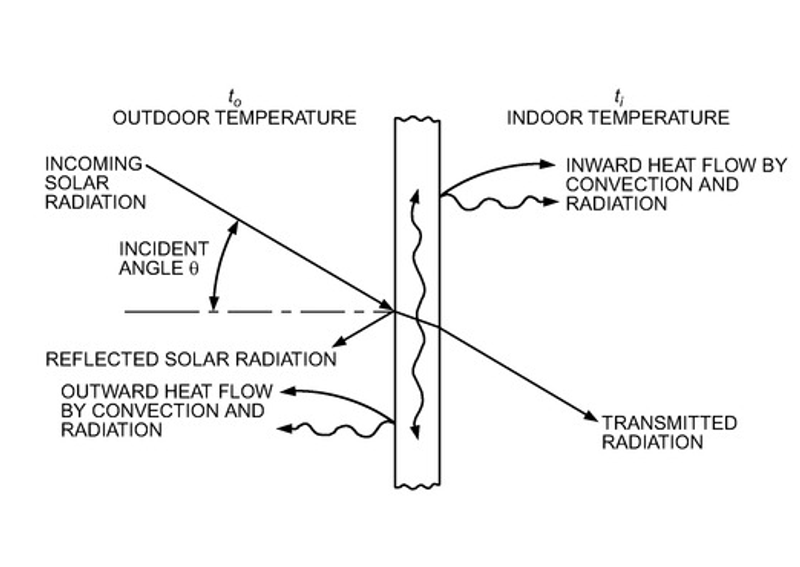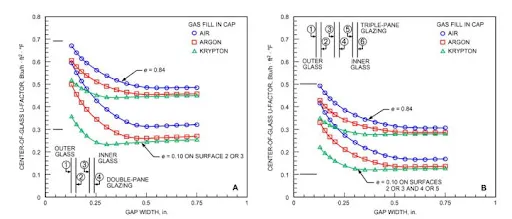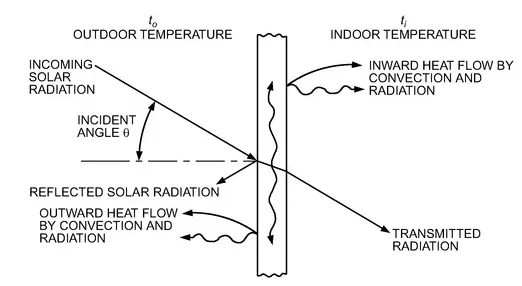
Windows play a significant role in building energy usage for both heating and cooling. In most buildings, the quality of window construction and installation will play a larger role on building envelope performance than any other aspect, and sometimes a larger role than the rest of the building envelope combined.
Window construction specifications include the number of panes, pane thickness, frame type, window style, glass coating, gap filler, and tint. The specific combinations of these will play a major role in how much heat and light can pass through the window. Installation quality will impact how much infiltration is able to get through the window cracks, which can lead to extra large heating loads in the winter and moisture migration in the summer.
Window construction quality has been continuously improving over the decades, but the cost of high quality windows has also been increasing, causing some building owners and developers to take the cheaper route. Most building and energy codes mandate minimum thermal performance of windows to ensure excess energy is not wasted on poor glazing. However, these minimum requirements are often enforced on window U-value, with little or no attention paid to the solar heat gain coefficient (SHGC). A good U-value can be nullified by poor installation quality, whereas a high-performance window with a good SHGC value will not be as affected by poor installation.
In modern commercial buildings glass is used not only for letting sunlight in, but, in the case of curtain walls, as a structural element as well. Increasing the quantity of glass on the building exterior can save energy on lighting, but since glass is not insulated in the same way walls are, and they allow the transmittance of solar radiation, the result is increased heating and cooling loads and a net increase in energy consumption.
ASHRAE publishes data collected on many window types, providing detailed information on SHGC, U-value, solar transmittance, and more. This data can be found in chapter 15 of the 2021 Fundamentals Handbook. Information on the quantity of infiltration through window cracks is harder to track down, and is significantly more complicated to calculate, but the data is available and shows that poor installation of windows will result in significantly higher infiltration.
 Figure 1: Correlations of U-value with Window Construction [1]
Figure 1: Correlations of U-value with Window Construction [1]
The U-value of a window only impacts the conduction of heat across the window assembly, without considering radiation passing through the window. Calculating the U-value of a window is a complicated procedure, and is dependent on window characteristics, temperature difference across the window, average temperature, wind, and more. Most building and energy codes will require that windows are tested based on a set of standard criteria to make sure that fair comparisons or U-values can be made between manufacturers. However, this means that accurately modelling the building energy usage may require more detailed information than just the published U-value.
The ASHRAE Fundamentals Handbook publishes typical U-values for a variety of window styles and construction combinations. This data shows a wide range of U-values, from 2.50 (single-pane garden window with aluminum frame) to 0.12 (4-pane fixed window with insulated fibreglass frame, ½” krypton-filled gaps). Since heat transfer is directly proportional to U-value, this means that heat would transfer through the first window 20x faster than the second.
The data also shows that the U-value of a window assembly can change by anywhere from 10% to 100% simply by changing the frame style, and by more than 15% when wind increases from 0 to 15 mph.
The Solar Heat Gain Coefficient (SHGC) is a measure of how much solar radiation that hits a window will make it into the space and contribute to the cooling load. The SHGC ranges from 0 (0% of sunlight entering the space) to 1 (100% of sunlight entering the space). Most windows range from around 0.4 to 0.9 for the direct beam value.
Some load calculation software packages will ask for a Shade Coefficient (SC) value, instead of the SHGC. The shade coefficient is an older version of SHGC, measuring essentially the same thing, with the exception that the common conversion between the two is SHGC = 0.87 x SC.
This simple conversion does not give credit to the complexity of the SHGC value. SHGC is a function of all window characteristics, as well as solar angle. Published data of the SHGC value for a manufactured glazing product is based on standard test procedures created by the National Fenestration Rating Council (NFRC) in North America, and other organizations in other parts of the world. This procedure requires manufacturers to publish the SHGC value at direct beam conditions at the centre of the glass. This ignores the impact that the window frame and edge of glass portions will have on determination of the SHGC. Additionally, direct beam conditions are quite rare, and will only happen when the sun is rising or setting, and therefore not during peak times for outdoor temperature. By only using a single (direct beam) value for the SHGC in your cooling load calculations, you may be oversizing cooling equipment by assuming maximum solar gain at the same time as peak window conduction.
 Figure 2: Solar Radiation Balance on Window Surface [1]
Figure 2: Solar Radiation Balance on Window Surface [1]
The SHGC value often has a bigger impact on window cooling load contribution than the U-value, however it is generally not as strictly regulated by energy codes. One characteristic that has a significant impact on the SHGC value is the tint of a window. Tinting a window lowers the SHGC, sometimes by more than 50%. Data for typical window products found in the Fundamentals Handbook shows the significant impacts of tint, pane thickness, and solar angle on the SHGC value.
In cold climates, infiltration will make up a large portion of the heating load. Infiltration happens through cracks in the structure, particularly around windows and doors. If a window is not installed properly, infiltration can be increased by more than 500% compared to tightly installed windows at high pressure differentials.
ASHRAE has published data on infiltration rates around window perimeters based on various pressure differentials and for different window types and installation quality. This data can be found in graphs and tables in the ASHRAE Cooling and Heating Load Calculation Manual.
During the cooling season, infiltration can lead to a buildup of moisture in the building structure, potentially warping materials and causing growth of mould and bacteria. During the heating season, if air exfiltrates, moisture can accumulate in the building structure and then freeze, causing severe damage to the building envelope.
For more information on infiltration, see our blog post by clicking here.
Shading devices on windows can decrease the cooling load during peak hours, depending on the nature of the device and solar angle at peak hours. Shading devices can be internal (blinds, curtains and shades), or external (overhangs and side fins). Both kinds reduce the solar radiation entering the space, but have no impact on conduction through the window.
It is important to include internal shading devices when performing cooling calculations, as they will have a major impact on solar loads. The effects of internal shadings are very complicated to model accurately because they depend on the solar angle, type of shading, and window characteristics. ASHRAE has tabulated empirical data of various types of shading devices in combination with different kinds of windows; although this data may not be perfect for each individual situation, it will provide a much more accurate estimate for cooling loads than simply ignoring internal shading.
Additional complications arise from the fact that internal shading devices are usually manually operated, and an occupant can simply open or close them as they wish. This can be mitigated by specifying roller shades that operate on a timer, becoming more predictable to incorporate into a cooling load calculation.
Impacts of external shading devices are far more easy to predict, since they are typically static attributes of the building structure. By knowing the dimensions of the shade, window, and solar angle, the effect of the shade can be completely determined for any hour of any day.
It is important to note that external shading devices do not fully eliminate solar radiation from entering the window, but rather eliminate the direct beam radiation. Solar radiation may still reflect off surrounding surfaces into the space, bypassing the shade.
 Figure 3: External Shading Angles [1]
Figure 3: External Shading Angles [1]
As modern buildings utilise more and more glass in building envelopes, selecting high quality windows and accurately modelling the behaviour of windows becomes increasingly important. Many factors influence window performance, and knowing which ones will make a difference can create massive energy savings throughout the lifetime of the building.
Applying a low-emissivity coating can improve the U-value and save on heating costs, but will have negligible impact on the solar heat gain. By tinting the windows and using internal shadings, solar heat gain can be significantly reduced, having a larger impact on cooling loads than an improved U-value.
Modelling the performance of windows can be extremely complicated, but is often the most important aspect for modelling the performance of the building envelope. Understanding the change in SHGC based on shading, solar angle, and window construction will play a major role in the final result of cooling loads.
HeatWise allows you to build a window based on known construction, or enter values manually. In either case, SHGC values for varying angles are then estimated from the direct beam value to realistically predict the performance at different solar angles. Internal and external shadings with customizable properties can also be added to windows. Effects from shading and solar angle adjustments are made by looking at statistical correlations from data published by ASHRAE to estimate values based on window type. The result is more accurate solar heat gain calculations for your cooling loads.
[1] American Society of Heating, Refrigeration, and Air Conditioning Engineers. 2021. “Chapter 15: Fenestration” In 2021 Fundamentals Handbook. Atlanta, GA: American Society of Heating, Refrigeration, and Air Conditioning Engineers.